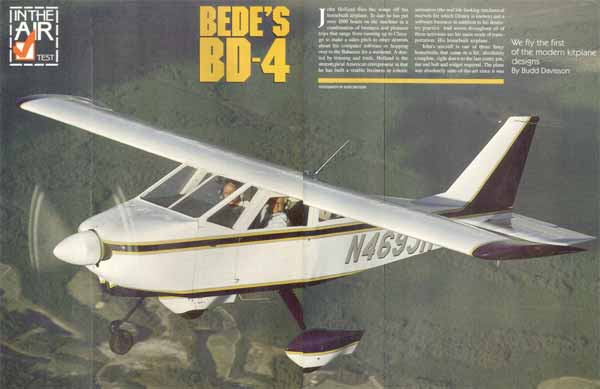John Holland flies the wings off his homebuilt
airplane. To date he has put over 1,500 hours on the machine in a combination
of business and pleasure trips that range from running up to Chicago
to make a sales pitch to other dentists about his computer software
or hopping over to the Bahamas for a weekend. A dentist by training
and trade, Holland is the stereotypical American entrepreneur in that
he has built a sizeable business in robotic animation (the real life-looking
mechanical marvels for which Disney is known) and a software business
in addition to his denistry practice. And woven throughout all of
these activities are his main mode of transportation: his homebuilt
airplane.
John’s aircraft is one of those fancy homebuilts that came in a
kit, absolutely complete,right down to the last cotter pin, nut and bolt
and widget required. The airplane was absolutely state-of-the-art since
it was designed to be built easy and fly fast.
What's he flying? A Lancair, a Glasair, or any of the other superkits?
Hardly! John Holland's homebuilt airplane that has continually
negated his need for a production craft is a BD-4. This slab-sided, Hershey
bar winged wonder first appeared as plans in 1968 and began showing up
in people's driveways as big kit boxes in 1970. Twenty years ago Bede
was already doing what most of sport aviation regarded as a phenomenon
of the 1980s — the completed kit concept.
 |
Both Wittman and Bede had
a knack for making square corners go fast. |
Jim Bede, the hyperkinetic leprechaun from Wichita, was nothing if not
innovative and creative. Bede gave us what appeared to be an endless
string of aircraft designs going from the BD-1 to the BD-10. With all
the furor over the controversial BD-5, it's easy for people to forget
that Bede has had other projects in his life. The various BD numbers
denote airplanes that are almost totally different from one another.
They range from a 65 horse every person's air-plane that eventually mutated
into the Grumman American line to the current dream-bird, the Mach two
BD-10 jet. Like we said, Jim is nothing if not innovative. Also, he pioneered
a large number of structural concepts, the most enduring being
the metal-to-metal bonding which, although hardly taking the industry
by storm, has certainly made the Grumman American line what it is.
The BD-4 is a combination of concepts that are not all that unusual in
designing personal four-place airplanes. It's the way Bede approached
these concepts that made them work. Basically what Jim wanted was an
airplane that must be a good cross-country personal machine, was easy
to build, and had to be a low-demanding machine for the average pilot
to fly. Nothing new here, but it's the way Bede approached
the design that made the airplane so different.
When the concept of cross-country was tossed into the kettle, Bede automatically
said the airplane had to have decent speed and long legs in the form
of lots of fuel. As designed, the airplane was supposed to have from
108 to 200-hp, although the 150s and 180s were the preferred engines.
The 108s were relegated to the two-place role. Sort of the Piper Colt
of the BD clan. The airplane's specification sheets boasted it would
do 175 or 80 with an 0-360 180-hp Lycoming in front. The design carried
52 gallons of fuel in the wings, the gallonage being an easier number
to obtain than the speed, as it turned out.
In the easy-to-build category, Bede broke lots of new ground. The most
obvious being the fuselage structure which used a .063 aluminum
angle bolted together to form a truss work with the skin bonded to
it. The wings were an innovative tour de force — depending on
your point of view.
The spars were almost a Bede signature since they were a large diameter
aluminum tube looking not unlike a piece of irrigation pipe.
Slid down over the brown spars were identical wing sections consisting
of airfoil shaped fiberglass tubs that were open at one end with the
other end featuring not only the rib, but it was joggled to allow the
next "tub" to snuggle over it for a good bonding surface.
The inboard sections of the wing were sealed to act as fuel tanks,
hence the 52 gallons. And this could be increased simply by opting
to utilize any of the other airfoil sections.
In an effort to keep the airplane as easy as possible to build, Bede
worked hard to eliminate those last minute runs to the local airplane
parts store. And to do this, he set up the kits so that they were complete
down to the last cotter pin. The kits were complete down to an engine
which, in 1970 dollars, sold for $5980 with the 150 Lycoming.
It's instructional to think that of the purchase price of
the BD-4 kits, $3-4000 consisted of the price of a 150 or
180-hp Lycoming. Speak of the good old days!
To keep the airplane strong in the easy-to-fly category, Jim Bede once
again stuck to his own guns in utilizing his own personal
definition of "easy!' Bede appears to appreciate the big airplane
characteristics offered through higher wing loadings in that the airplanes
are less bothered by winds and turbulence and the absolute definitive
BD handling package can be seen in the early series Grumman American
Yankees. Actually, as originally conceived, the AA-1 Yankee
was to be the cheapest personal airplane available with the purchase
price being $2500 when utilizing an overhauled 65 horse Continental.
It's a little hard to get a handle on exactly how many BD-4s
have been built but, in 1970, the last time goodold Air Progress ran
a story on the airplane, an excess of 350 kits had been ordered. So it's
fair to guess that maybe as many as 500 kits were sold for a total of
2-300 completed airplanes.
GO TO NEXT PAGE
|

